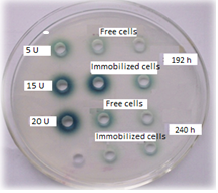 |
|
Azo dyes released in wastewaters of textile industry are an important factor of environmental pollution. The use of immobilized white rot fungi cells is considered the best alternative to decolorize these effluents. In this work, a 2k factorial design was applied to increase the specific decolorization rate (rd) of Reactive Black 5 (RB5) by Trametes versicolor, using free (FC) and immobilized cells (IC). The results indicated that IC were more efficient than FC for RB5 decolorization. Immobilization modified fungal metabolism with a decrease in CO2 production, while laccases increased in presence of RB5. Decolorization process at bioreactor showed that IC (removal of 84% in 24 h) were more efficient than FC (85 % in 144 h). The decolorization of RB5 analyzed using UV–vis spectrophotometry suggested that degradation was the main mechanism for dye removal by IC, whereas in FC both absorption and degradation contributed to color removal.
Keywords: fungi, azo dye, polyurethane foam, response surface, intrinsic parameters, effectiveness factor.
|
|
 |

